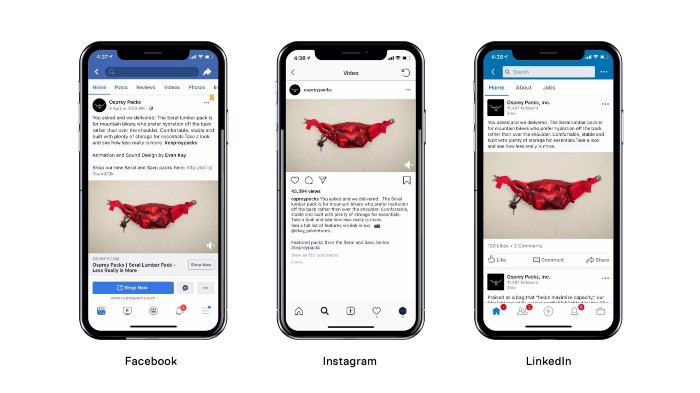When it comes to social media content, one size doesn’t fit all. Ideally brands would produce and share different types of content to each of the different platforms, but we realize that this isn’t realistic for marketers working on tight timeframes and budgets. As a result, our tried-and-true content hack to stretch content further and to keep your social channels consistently active is called cross-posting.
Our Social Media Content Hack
Cross-Post to Stretch Your Content Further
Diversifying content across platforms can seem like a daunting task, but it doesn’t have to be. You can make efficient use of your time and resources with a practice called cross-posting.
“Cross-posting content allows you to take a single piece of content and use it across many different platforms – keeping your social media accounts active and healthy” (SEMRUSH).
It’s a great practice for smaller businesses or brands that can’t spend thousands of dollars on several recipes, photos, videos, etc. Essentially, it will allow you to do more with less.
 Example of Cross-Posting from Medium.com
Example of Cross-Posting from Medium.com
Don’t Forget to Diversify
You might be thinking that cross-posting sounds extremely simple. Not so fast. It is not enough to just blast the same messaging across multiple channels. With different restrictions (like the number of characters) and different audiences and focuses (text vs. visual), you need to tweak your content to accommodate the platform and the type of audience you are trying to reach. For example, consider that infographics are great for Pinterest but for Instagram, you have a much smaller visual space to work with and it can be overwhelming to include all of those details on one Instagram post. To appropriately cross-promote, you would want to revise your content to make it more digestible and share parts of the infographic as individual posts or a carousel on Instagram.
In a perfect world, content is being created specifically with each platform in mind and if you have the budget to do this at times, you should. For most fresh produce marketers, you’ll want to consider how you can change what you are already sharing to better fit each platform by changing up the caption, adjusting the image size, adding more images, using a video instead of a link, etc. Here’s what we suggest to post on each platform based on what we’ve seen works best:
Content that works best for each platform
- Link to articles, blog posts, or recipes – Facebook is ideal for garnering more visitors to your website especially if you boost your social posts with a “traffic” objective
- Video – Facebook is more capable to handle longer videos; however, we recommend sticking to about one minute
- High-resolution photos of recipes, lifestyle photos, or beautiful behind-the-scenes images of the farms or fields
- Text graphics – these should be clean and concise. If it’s too cluttered with too many stats or information, it’s sure to be scrolled past
- Quick 15-30 second videos/reels
- Memes *if* it fits with your brand strategy. Do some research first to see what memes are popular at the moment and make sure it fits
- Inspirational or messages or quotes with an attractive design
- Copy should be short and to the point
- Capitalize on links and trending hashtags here
- Re-sharing content from employees, C-suite, or partners – be sure to add your own comments
- Long text content is more appropriate on this platform if it is in the form of thought leadership articles or discussion topics
- Job hiring opportunities
- Behind-the-scenes of production and work-life at the company
- Educational content your customers may find helpful, like supply chain insights or crop updates
- Informational, educational, or inspirational content (ex. Infographics)
- Content that is dimensionally vertically long
- Recipes with an added recipe title headline will stand out
We are still learning about what works best for brands on TikTok, and right now it seems it is best to leave the content creation up to influencers working on behalf of your brand. Find out what we’ve already discovered about the platform here.
Consider Your Timing
The time of day you scroll through Instagram isn’t the same as when you hop onto LinkedIn or Twitter. Planning tools like Sprout and Gain can help in planning out, scheduling, and optimizing your publish dates and times to make sure you’re reaching your audience at the right time and place. Look at your engagement numbers for posts published at different times to help you see what timing suits your audiences best. Keep testing – the internet is ever-changing, and so are people’s preferred time to engage with your content.
If you’re in need of some inspiration, download our 2022 Social Media Calendar filled with useful dates allowing you to capitalize on holidays, events, and food/drink days that matter most to your audiences!
Take your social media to the next level
Our social media team will personally review your content and provide actionable recommendations to improve with our quick and affordable Social Media Audit. Click below to book yours today!
{{cta(’78d3fee5-7e8f-4f2a-b7d6-64eb5db8389f’)}}
